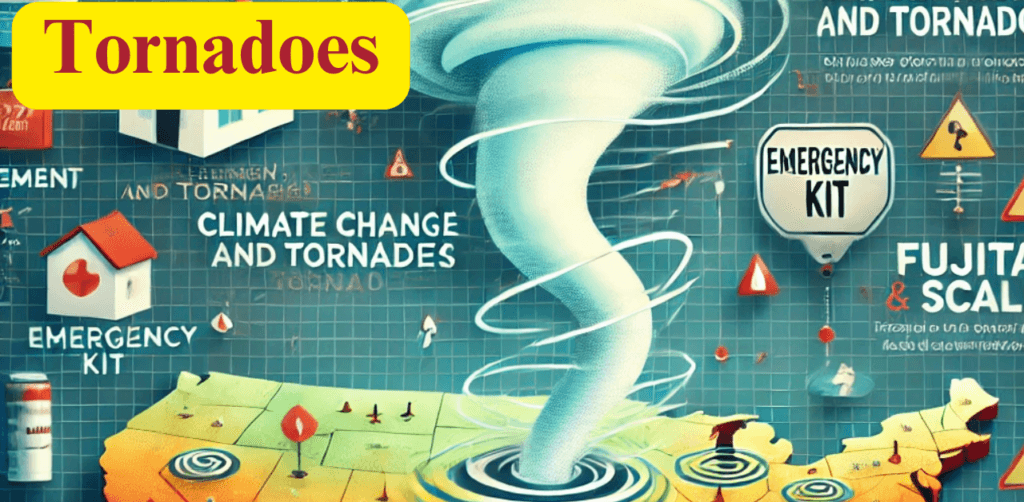
Table of Contents
Tornadoes: Understanding Their Impact and How to Stay Safe – Latest Insights
Tornadoes : Tornadoes are among nature’s most intense and destructive phenomena. These rapidly rotating columns of air can cause catastrophic damage in minutes. Whether you’re living in Tornado Alley or a region where tornadoes are less common, it’s essential to understand the latest information about tornadoes, how they form, their impacts, and how you can prepare for them.
What is a Tornado?
A tornado is a violent, rotating column of air that connects a thunderstorm with the ground. They form when warm, moist air collides with cool, dry air, creating an unstable environment that triggers rotation. As the rotation intensifies, it forms a tornado. The wind speeds of tornadoes can vary significantly, ranging from 65 mph in weak tornadoes to over 300 mph in the most extreme cases, making them capable of massive destruction.
Example: On April 4, 2024, a powerful EF3 tornado struck Missouri, causing significant damage to buildings and infrastructure. The storm, with winds reaching over 140 mph, highlighted the importance of preparedness in tornado-prone areas.

Recent Tornado Trends and Climate Change Impact
Recent weather data suggests an increase in tornado frequency and intensity, particularly in the central United States, commonly known as Tornado Alley. Tornadoes are also being observed in regions previously less prone to them, such as parts of the Southeast U.S. and East Coast. Some experts believe that climate change may be contributing to this shift by creating more favorable conditions for extreme weather events.
Example: In 2023, tornadoes were reported in regions like Kentucky and Tennessee, which historically have seen fewer tornadoes. Scientists warn that climate change could lead to more unpredictable weather patterns, including stronger tornadoes in areas outside traditional tornado zones.
The Impact of Tornadoes
Tornadoes can cause severe damage, leaving communities devastated. Not only can tornadoes destroy homes and businesses, but they can also cause fatalities, injuries, and long-term economic setbacks. The Fujita Scale, ranging from F0 (weak) to F5 (devastating), measures the intensity of a tornado based on its wind speed and the damage caused.
Example: The Joplin, Missouri, tornado of 2011, which was an F5, resulted in the deaths of over 150 people and left thousands of homes destroyed. The recovery efforts took years, with many changes in building codes and emergency preparedness following the event.
Preparing for a Tornado
While tornadoes cannot be avoided, preparation can make a significant difference in survival. Here are some critical steps to ensure you are ready if a tornado strikes:
- Stay Informed: Keep an eye on local weather warnings. Use reliable sources like the National Weather Service for up-to-date tornado warnings and alerts.Example: In April 2024, the National Weather Service issued a tornado warning for several counties in Alabama, giving residents critical time to take shelter and prepare for a tornado that ultimately touched down at an EF2 strength.
- Create a Tornado Plan: Designate a safe room in your home, such as a basement, interior room, or storm shelter. If you’re in a mobile home or outside, seek sturdy shelter immediately.
- Emergency Kit: Prepare an emergency kit with food, water, a flashlight, batteries, and first-aid supplies. Keep this kit in your safe room for easy access.
- Reinforce Your Home: In tornado-prone areas, ensure your home is built with reinforced structures to withstand strong winds. This can include having a storm shelter or reinforced basement.Example: After the devastating 2011 Joplin tornado, local authorities worked on increasing the number of community storm shelters and improved building codes in tornado-prone areas.
- Community Alert Systems: Many areas have sirens or other warning systems. Know what to do when you hear these alerts.
Advances in Tornado Detection Technology
Technology has significantly improved tornado detection, allowing for more accurate and earlier warnings. Doppler radar plays a crucial role in tracking tornadoes by detecting rotating storm patterns that signal tornado formation.
Additionally, storm chasers and mobile technology provide real-time data from the field, helping meteorologists refine tornado forecasts.
Example: In March 2024, a mobile weather station set up by storm chasers in Kansas helped track a tornado’s exact path, allowing nearby residents to receive an earlier warning and take cover.
Tornado Safety: What You Need to Know
When a tornado warning is issued, it’s essential to act quickly and stay calm. Here are some key tornado safety tips:
- Take Shelter: The safest place to be during a tornado is in a basement or storm cellar. If that’s not an option, move to a small interior room on the lowest floor, away from windows.
- Protect Your Head and Neck: Use heavy furniture or mattresses to protect yourself from debris. If you’re caught outside or in a car, lie flat in a ditch, covering your head and neck.
- Know the Difference Between a Tornado Watch and a Warning: A tornado watch means conditions are favorable for tornadoes to develop, while a warning indicates that a tornado has been sighted or detected by radar.
Conclusion: Staying Safe in Tornadoes
Tornadoes remain unpredictable, but advancements in technology, better public awareness, and improved preparation strategies are helping to reduce the loss of life and property damage. With the potential increase in tornado occurrences due to climate change, staying informed, preparing your family and home, and reinforcing community efforts will be essential in safeguarding against future tornadoes.
By following these safety tips and learning from recent events, such as the 2024 Missouri tornado, individuals can better prepare for these natural disasters and protect themselves from the destructive power of tornadoes.
Also Read This : https://networkbharat.com/overcoming-procrastination/


